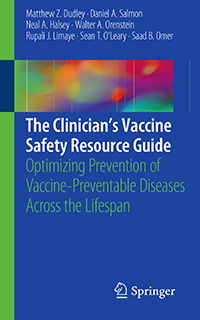International Health Student and Faculty Publish New Vaccine Safety Book

According to research led by the Johns Hopkins Institute for Vaccine Safety, anti-vaxxers make up merely 1-2 percent of the U.S. population. However, a much larger proportion have questions about the safety of vaccines, especially when it comes to their children. With the worst-ever measles outbreak raging in the US in 20 years, it’s critical for the public to know the facts about vaccines. For over two decades, the Institute, which is based in the Department of International Health, has been a leader in providing comprehensive and trusted vaccine safety information.
To help combat the rise in vaccine misinformation, International Health Faculty Associate Matthew Dudley, PhD ’19, led the development of The Clinician’s Vaccine Safety Resource Guide. Dudley, an epidemiologist at the Institute, finished the book while he was a doctoral student in the Department’s Global Disease Epidemiology and Control Program.

As parents’ most trusted source of information on vaccines, the Guide offers health care providers approaches and concrete examples of how to better address parents’ concerns. The book helps physicians, who receive little to no training on how to communicate about vaccines, shift conversations away from vaccine falsehoods and fears to focus on the real risk of disease if children remain unvaccinated. Each topic, from specific vaccines to safety concerns, is based upon systematic reviews of the latest scientific literature and includes talking points to use with patients.
Other International Health authors in the collaborative effort include Professor Dan Salmon, Director of the Institute for Vaccine Safety (IVS); Emeritus Professor Neal Halsey, Founding Director of IVS; and Assistant Scientist Rupali Limaye, Associate Director for Behavioral Research at IVS. Researchers from Emory University and the University of Colorado School of Medicine were also contributing authors. The book, which is available in print and digitally from Springer, has already been downloaded over 12,000 times.
